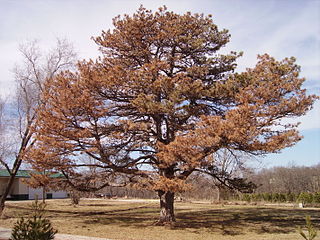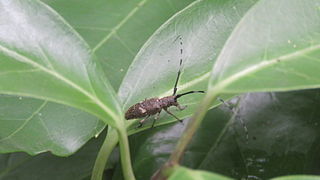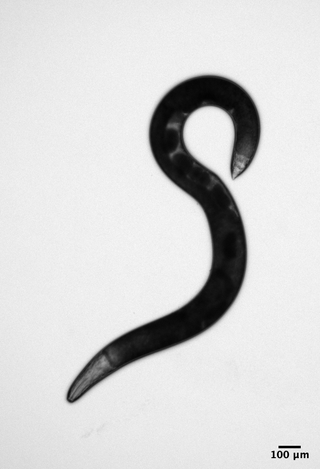
A bark beetle is the common name for the subfamily of beetles Scolytinae. Previously, this was considered a distinct family (Scolytidae), but is now understood to be a specialized clade of the "true weevil" family (Curculionidae). Although the term "bark beetle" refers to the fact that many species feed in the inner bark (phloem) layer of trees, the subfamily also has many species with other lifestyles, including some that bore into wood, feed in fruit and seeds, or tunnel into herbaceous plants. Well-known species are members of the type genus Scolytus, namely the European elm bark beetle S. multistriatus and the large elm bark beetle S. scolytus, which like the American elm bark beetle Hylurgopinus rufipes, transmit Dutch elm disease fungi (Ophiostoma). The mountain pine beetle Dendroctonus ponderosae, southern pine beetle Dendroctonus frontalis, and their near relatives are major pests of conifer forests in North America. A similarly aggressive species in Europe is the spruce ips Ips typographus. A tiny bark beetle, the coffee berry borer, Hypothenemus hampei is a major pest on coffee plantations around the world.

Stilbenoids are hydroxylated derivatives of stilbene. They have a C6–C2–C6 structure. In biochemical terms, they belong to the family of phenylpropanoids and share most of their biosynthesis pathway with chalcones. Most stilbenoids are produced by plants, and the only known exception is the antihelminthic and antimicrobial stilbenoid, 2-isopropyl-5-[(E)-2-phenylvinyl]benzene-1,3-diol, biosynthesized by the Gram-negative bacterium Photorhabdus luminescens.

Rotylenchulus reniformis, the reniform nematode, is a species of parasitic nematode of plants with a worldwide distribution in the tropical and subtropical regions.

Monochamus is a genus of longhorn beetles found throughout the world. They are commonly known as sawyer beetles or sawyers, as their larvae bore into dead or dying trees, especially conifers such as pines. They are the type genus of the Monochamini, a tribe in the huge long-horned beetle subfamily Lamiinae, but typically included in the Lamiini today.

Bursaphelenchus xylophilus, commonly known as pine wood nematode or pine wilt nematode (PWN), is a species of nematode that infects trees in the Pinus genus of coniferous trees and causes the disease pine wilt. While native to North America, it spread in the early 20th century to Japan and in the latter half of the century to other areas of Asia, including China, Taiwan, and Korea, as well as to Europe, including Portugal and Spain.
The red ring disease of coconuts and African oil palms is caused by the nematode Bursaphelenchus cocophilus. It is also identified in literature with an alternative scientific name Rhadinaphelenchus cocophilus. The common name, the red ring nematode, is derived from its distinguishing symptom.

A wilt disease is any number of diseases that affect the vascular system of plants. Attacks by fungi, bacteria, and nematodes can cause rapid killing of plants, large tree branches or even entire trees.

Emamectin is the 4″-deoxy-4″-methylamino derivative of abamectin, a 16-membered macrocyclic lactone produced by the fermentation of the soil actinomycete Streptomyces avermitilis. It is generally prepared as the salt with benzoic acid, emamectin benzoate, which is a white or faintly yellow powder. Emamectin is widely used in the US and Canada as an insecticide because of its chloride channel activation properties.
Caenorhabditis japonica is a species of nematodes in the genus Caenorhabditis. Its genome was sequenced by the McDonnell Genome Institute at Washington University School of Medicine. This gonochoristic species is found in the 'Japonica' group, the sister clade to the 'Elegans' group, in the 'Elegans' supergroup.
Heterodera zeae, the corn cyst nematode (CCN), is a plant parasitic nematode that feeds on Zea mays (maize/corn). The CCN has a limited economic impact worldwide due to its high soil temperature requirements.
Aphelenchoididea is a nematode superfamily in the order Rhabditida. Its members can be found inside bodies of species from the families Lepidoptera and Blattodea.
Micoletzkya is a genus of predatory bark-beetle-associated nematodes in the family Diplogastridae. The genus was named for the Austrian nematologist Heinrich Micoletzky. As of 2013 it consists of 25 described species.

Pristionchus is a genus of nematodes (roundworms) in the family Diplogastridae that currently includes more than 50 described species. They are known mainly as non-parasitic associates of insects, especially beetles, while others have been reported from soil, organic matter, or rotting wood. The genus includes P. pacificus, a satellite model organism to the well-studied nematode Caenorhabditis elegans.
Sudhausia is a genus of nematodes (roundworms) of the family Diplogastridae. They live in association with dung beetles and are primarily known from Africa. Species of Sudhausia show a suite of biological features that, together, are unusual for nematodes and animals in general: hermaphrodites, which are females in form, mature to produce offspring before they are adults and thus even capable of mating, and their eggs grow in size during development. Hermaphrodites are also always live-bearing, which is unusual for nematodes under non-stressful conditions. The genus is named in honor of Walter Sudhaus, a German nematologist.
Levipalatum texanum is a free-living nematode (roundworm) in the family Diplogastridae. The species is androdioecious, consisting of self-fertile hermaphrodites which are morphologically females, and males. It is known from the south-eastern United States and has been found to live in association with scarab beetles, although it has also been baited from soil. Nematodes of this species can be cultured on bacterium Escherichia coli in the laboratory, and they are presumed to also feed on microorganisms in the wild. Levipalatum is a monotypic genus.

Monochamus subfasciatus is a species of beetle in the family Cerambycidae. It was described by Henry Walter Bates in 1873. It is recorded from Japan where it infests Japanese red pine and is a vector of the nematode Bursaphelenchus doui.

Monochamus alternatus, the Japanese pine sawyer, is a species of beetle in the family Cerambycidae. It was described by Frederick William Hope in 1842. It is known from Hong Kong, Vietnam, Laos, North Korea, South Korea, Japan, China, and Taiwan. It feeds on Pinus banksiana, Abies firma, Pinus armandii, Pinus massoniana, Pinus yunnanensis, and Pinus densiflora. It serves as a vector for the nematode Bursaphelenchus xylophilus.

Monochamus galloprovincialis, the pine sawyer beetle, also referred to as the black pine sawyer beetle, is a species of beetle in the family Cerambycidae. It was described by Olivier in 1795, originally under the genus Cerambyx. It has a wide distribution, occurring naturally throughout Europe and the Caucasus. It has also been introduced into the Canary Islands. It serves as a vector for the parasitic nematode species Bursaphelenchus xylophilus, and also acts as a host to the parasitoid wasp species Dolichomitus tuberculatus.
Myolaimidae is a family of nematodes in the order Rhabditida. It consists of two genera, Myolaimus and Deleyia.

Allodiplogaster sudhausi is a free-living nematode species in the Diplogastridae family. It was described in 2008 as Koerneria sudhausi, before being moved to the genus Allodiplogaster in 2014. A. sudhausi is omnivorous. It predates on other nematodes, but can be cultured on Escherichia coli OP50 bacterium on agar.












